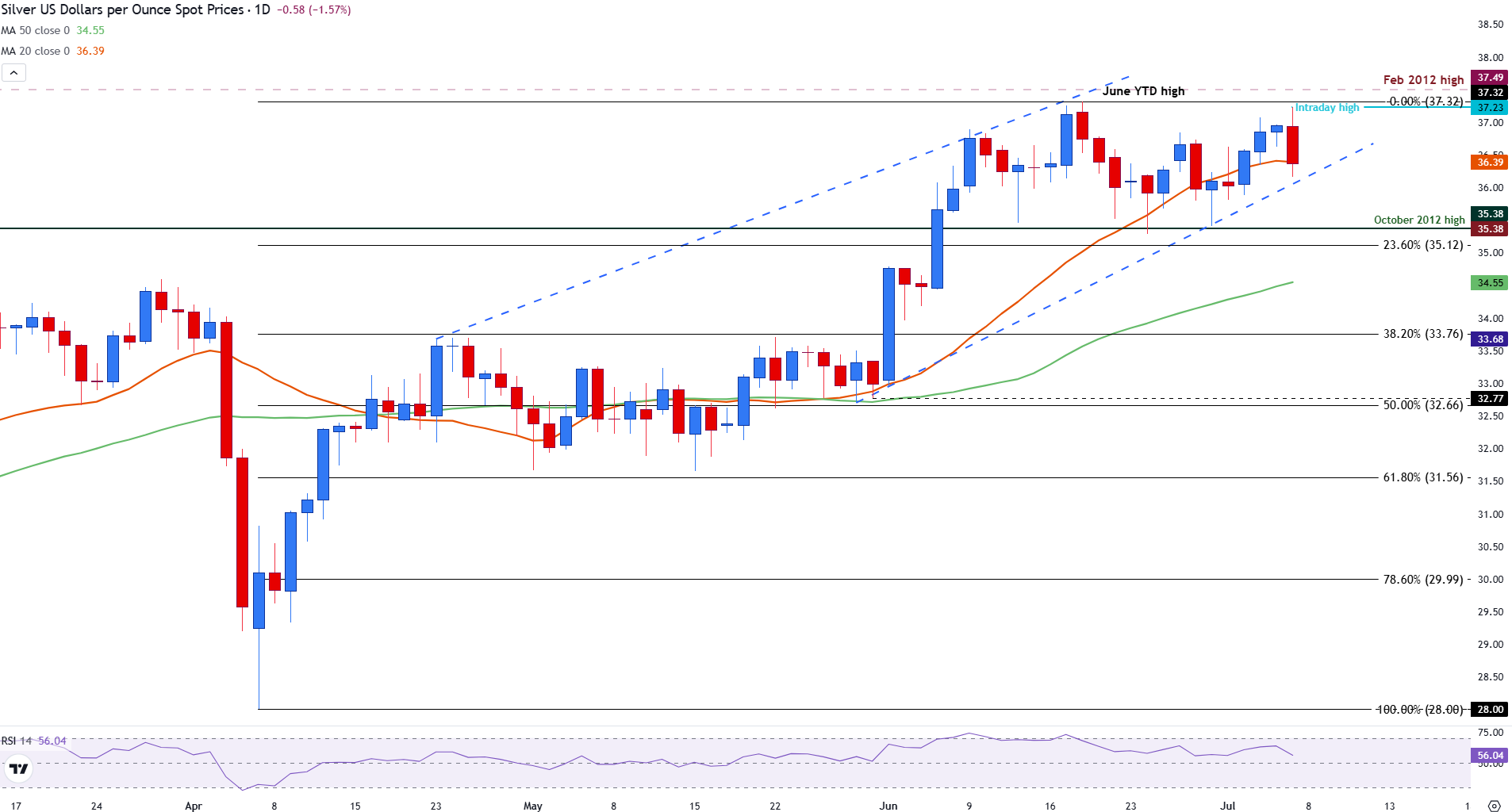Silver slides as a rebound in yields supports a stronger US Dollar
- Silver price slumps as Fed policy realignment adds pressure on precious metals.
- US Dollar strength and rising yields weigh on Dollar-denominated commodities.
- XAG/USD nears trendline support as technical breakdown threat looms below $36.00.
Silver bulls are suffering losses Monday as the strong US Dollar and rising US yields reduce demand for precious metals.
XAG/USD is falling toward the psychological support level of $36.00 at the time of writing. Intraday losses for the white metal are currently approaching the 1.60% mark.
The decline in the Silver price has primarily been due to the recovery in the value of the US Dollar. Treasury yields and renewed hope in the world trade negotiations are prominent drivers of current price action.
Traders have also welcomed the recent comments by President Donald Trump, who stated that trade negotiations with key trading partners are “going well” prior to the July 9 tariff deadline.
This has encouraged investors to move away from safe-haven assets, such as Silver and Gold.
Additionally, Germany released its May Industrial Production data, which showed an annual increase of 1% (up from a 2.1% contraction in April). The monthly figure increased 1.2%, while markets had anticipated it to remain unchanged.
Additionally, China’s foreign exchange reserves for June came in at $3.317 trillion, slightly above consensus expectations, which supports a more stable macroeconomic backdrop.
Alongside that pressure southwards was the realignment in the Federal Reserve's (Fed) monetary policy stance in reaction to Thursday’s better-than-expected US Nonfarm Payrolls (NFP) data.
These data points have reinforced investor confidence in global economic growth, reducing the demand for traditional safe-haven assets.
Silver technical analysis: XAG/USD slumps, $36.00 in focus
Technically, Silver is struggling to maintain upward momentum after falling from the $37.00 region, with price action pulling back sharply at the time of writing.
Silver (XAG/USD) daily chart

The current candle on the daily chart suggests increasing downside risk, particularly if there is a clear break of the $36.00 psychological level. This level aligns with the trendline support of the rising channel.
A break below this level could expose deeper support zones, including the 23.6% Fibonacci extension level of the April-June uptrend at $35.12. The 50-day Simple Moving Average (SMA) is at $34.54, which could serve as another important level for bears trading XAG/USD.
For Silver to recover, a hold above the 20-day SMA at 36.38 is in play, opening the door for Monday’s intraday high at $37.23.
Silver FAQs
Silver is a precious metal highly traded among investors. It has been historically used as a store of value and a medium of exchange. Although less popular than Gold, traders may turn to Silver to diversify their investment portfolio, for its intrinsic value or as a potential hedge during high-inflation periods. Investors can buy physical Silver, in coins or in bars, or trade it through vehicles such as Exchange Traded Funds, which track its price on international markets.
Silver prices can move due to a wide range of factors. Geopolitical instability or fears of a deep recession can make Silver price escalate due to its safe-haven status, although to a lesser extent than Gold's. As a yieldless asset, Silver tends to rise with lower interest rates. Its moves also depend on how the US Dollar (USD) behaves as the asset is priced in dollars (XAG/USD). A strong Dollar tends to keep the price of Silver at bay, whereas a weaker Dollar is likely to propel prices up. Other factors such as investment demand, mining supply – Silver is much more abundant than Gold – and recycling rates can also affect prices.
Silver is widely used in industry, particularly in sectors such as electronics or solar energy, as it has one of the highest electric conductivity of all metals – more than Copper and Gold. A surge in demand can increase prices, while a decline tends to lower them. Dynamics in the US, Chinese and Indian economies can also contribute to price swings: for the US and particularly China, their big industrial sectors use Silver in various processes; in India, consumers’ demand for the precious metal for jewellery also plays a key role in setting prices.
Silver prices tend to follow Gold's moves. When Gold prices rise, Silver typically follows suit, as their status as safe-haven assets is similar. The Gold/Silver ratio, which shows the number of ounces of Silver needed to equal the value of one ounce of Gold, may help to determine the relative valuation between both metals. Some investors may consider a high ratio as an indicator that Silver is undervalued, or Gold is overvalued. On the contrary, a low ratio might suggest that Gold is undervalued relative to Silver.


